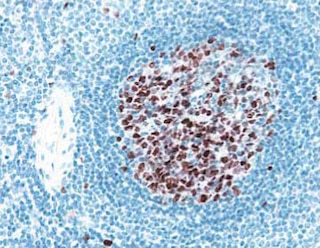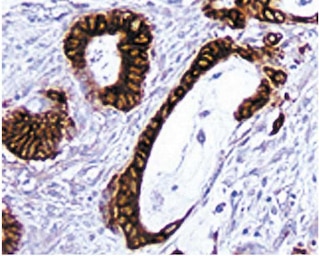Old Browser
Looks like you're visiting us from {countryName}.
Would you like to stay on the current country site or be switched to your country?




Immunohistochemical staining of CD44 positive cells. Formalin-fixed paraffin sections of normal mouse spleen after antigen retrieval were reacted with the anti-CD44 antibody. CD44 positive cells can be identified by the brown labeling of their cell membranes. Amplification 20X.


BD Pharmingen™ Purified Rat Anti-Mouse CD44

监管状态图例
未经BD明确书面授权,严禁使用未经许可的任何商品。
准备和存储
推荐的实验流程
Immunohistochemistry: The IM7 antibody specific for mouse CD44 is recommended to test for immunohistochemical staining of formalin-fixed paraffin and acetone-fixed frozen sections. Antigen retrieval with BD Retrievagen A (Cat. No. 550524) is required for formalin-fixed paraffin sections. Tissues tested were mouse spleen and thymus. The antibody stains epithelial cell and T and b lymphocytes. The isotype control recommended for use with this antibody is purified rat IgG2b (Cat. No. 559478). For optimal indirect immunohistochemical staining, the IM7 antibody should be titrated (1:10 to 1:50 dilution) and visualized via a three-step staining procedure in combination with biotin conjugated anti-rat IgG 2b (Cat. No. 550327) as the secondary antibody and Streptavidin-HRP (Cat. No. 550946) together with the DAB detection system (Cat. No. 550880).
A detailed protocol of the immunohistochemical procedure is available at our website, http://www.bdbiosciences.com/support/resources
商品通知
- Since applications vary, each investigator should titrate the reagent to obtain optimal results.
- Caution: Sodium azide yields highly toxic hydrazoic acid under acidic conditions. Dilute azide compounds in running water before discarding to avoid accumulation of potentially explosive deposits in plumbing.
- Source of all serum proteins is from USDA inspected abattoirs located in the United States.
- An isotype control should be used at the same concentration as the antibody of interest.
- This antibody has been developed for the immunohistochemistry application. However, a routine immunohistochemistry test is not performed on every lot. Researchers are encouraged to titrate the reagent for optimal performance.
- Please refer to www.bdbiosciences.com/us/s/resources for technical protocols.
配套商品






The IM7 antibody specifically recognizes an epitope on both alloantigens and all isoforms of the CD44 glycoprotein (Pgp-1, Ly-24). The standard form of CD44, lacking variable exons and referred to as CD44H or CD44s, is widely expressed on hematopoietic and non-hematopoietic cells. CD44 isoforms encoded by variable exons are expressed on epithelial cells, but only at low levels on most leukocytes. Mice with the Ly-24.1 alloantigen (e.g., BALB/c, CBA/J, DBA/1, DBA/2) have relatively large subsets of CD44H+ T lymphocytes, while Ly-24.2 strains (e.g., A, AKR, CBA/N, C3H/He, C57BL, C57BR, C57L, C58, NZB, SJL, SWR, 129) have fewer CD44H+ T cells. CD44 is a cell adhesion receptor, and its principal ligand, hyaluronate, is a common component of extracellular matrices. Differential glycosylation of CD44 influences its binding to hyaluronate. Additional ligands include the cell surface form of CD74 and the cytokine osteopontin (Eta-1). Bone marrow- and thymus-derived progenitor cells capable of repopulating the thymus express CD44. In the periphery, the level of CD44 expression increases upon activation of B lymphocytes, CD4+ T cells, and CD8+ T cells; memory cells can be recognized by their CD44[hi] phenotype. The IM7 mAb inhibits established collagen-induced arthritis in DBA/1 mice. Moreover, it prevents CNS inflammation and clinical symptoms of experimental autoimmune encephalomyelitis. In contrast, the same antibody exacerbates experimental autoimmune thyroiditis in CBA/J mice. The IM7 mAb recognizes a different epitope from that recognized by mAb KM114, and the antibody pair can be used in ELISA to detect soluble CD44. It has been observed that IM7 antibody crossreacts with human, dog, cat, horse, cow, and pig leukocytes. Anti-human CD44, clone G44-26, and IM7 antibody compete for binding to human peripheral blood lymphocytes.
研发参考 (12)
-
Bendelac A. Mouse NK1+ T cells. Curr Opin Immunol. 1995; 7(3):367-374. (Biology). 查看参考
-
Budd RC, Cerottini JC, Horvath C, et al. Distinction of virgin and memory T lymphocytes. Stable acquisition of the Pgp-1 glycoprotein concomitant with antigenic stimulation. J Immunol. 1987; 138(10):3120-3129. (Biology). 查看参考
-
Hyman R, Lesley J, Schulte R, Trotter J. Progenitor cells in the thymus: most thymus-homing progenitor cells in the adult mouse thymus bear Pgp-1 glycoprotein but not interleukin-2 receptor on their cell surface. Cell Immunol. 1986; 101(2):320-327. (Biology). 查看参考
-
Katoh S, McCarthy JB, Kincade PW. Characterization of soluble CD44 in the circulation of mice. Levels are affected by immune activity and tumor growth. J Immunol. 1994; 153(8):3440-3449. (Biology). 查看参考
-
Katoh S, Zheng Z, Oritani K, Shimozato T, Kincade PW. Glycosylation of CD44 negatively regulates its recognition of hyaluronan. J Exp Med. 1995; 182(2):419-429. (Biology). 查看参考
-
Lesley J, Hyman R, Kincade PW. CD44 and its interaction with extracellular matrix. Adv Immunol. 1993; 54:271-335. (Biology). 查看参考
-
Lesley J, Trowbridge IS. Genetic characterization of a polymorphic murine cell-surface glycoprotein. Immunogenetics. 1982; 15(3):313-320. (Immunogen). 查看参考
-
Lynch F, Ceredig R. Mouse strain variation in Ly-24 (Pgp-1) expression by peripheral T cells and thymocytes: implications for T cell differentiation. Eur J Immunol. 1989; 19(2):223-229. (Biology). 查看参考
-
Naor D, Sionov RV, Ish-Shalom D. CD44: structure, function, and association with the malignant process. Adv Cancer Res. 1997; 71:241-319. (Biology). 查看参考
-
Trowbridge IS, Lesley J, Schulte R, Hyman R, Trotter J. Biochemical characterization and cellular distribution of a polymorphic, murine cell-surface glycoprotein expressed on lymphoid tissues. Immunogenetics. 1982; 15:299-312. (Immunogen). 查看参考
-
Vremec D, Zorbas M, Scollay R, et al. The surface phenotype of dendritic cells purified from mouse thymus and spleen: investigation of the CD8 expression by a subpopulation of dendritic cells. J Exp Med. 1992; 176(1):47-58. (Biology). 查看参考
-
Weber GF, Ashkar S, Glimcher MJ, Cantor H. Receptor-ligand interaction between CD44 and osteopontin (Eta-1). Science. 1996; 271(5248):509-512. (Biology). 查看参考
Please refer to Support Documents for Quality Certificates
Global - Refer to manufacturer's instructions for use and related User Manuals and Technical data sheets before using this products as described
Comparisons, where applicable, are made against older BD Technology, manual methods or are general performance claims. Comparisons are not made against non-BD technologies, unless otherwise noted.
For Research Use Only. Not for use in diagnostic or therapeutic procedures.
Report a Site Issue
This form is intended to help us improve our website experience. For other support, please visit our Contact Us page.